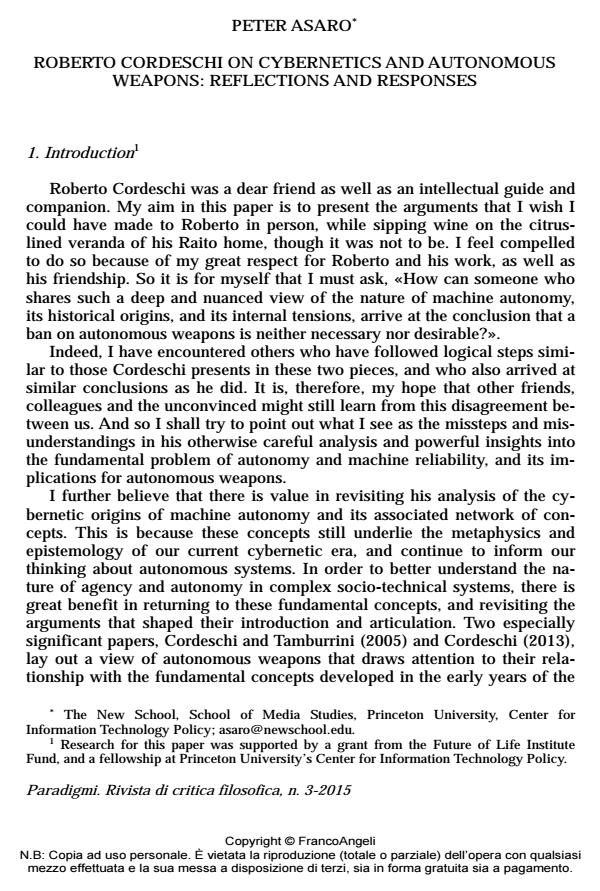Roberto cordeschi on cybernetics and autonomous weapons: reflections and responses
Journal title PARADIGMI
Author/s Peter Asaro
Publishing Year 2016 Issue 2015/3
Language English Pages 25 P. 83-107 File size 94 KB
DOI 10.3280/PARA2015-003006
DOI is like a bar code for intellectual property: to have more infomation
click here
Below, you can see the article first page
If you want to buy this article in PDF format, you can do it, following the instructions to buy download credits

FrancoAngeli is member of Publishers International Linking Association, Inc (PILA), a not-for-profit association which run the CrossRef service enabling links to and from online scholarly content.
Cordeschi e Tamburrini (2005) e Cordeschi (2013), trattando delle armi autonome, collocano le origini di questi sistemi all’interno della storia della cibernetica. Considerare le armi autonome da questo punto di vista non è solo un proficuo esercizio storico, ma rivela alcune profonde idee su cosa siano realmente tali armi, sulle ragioni per cui trovano possiamo considerarle discutibili o indesiderabili, e su come sia possibile "addomesticarle" con strumenti ingegneristici. In particolare, Cordeschi (2013) sviluppa gli argomenti di Wiener (1960) sull’affidabilità dei sistemi autonomi e sui potenziali pericoli derivanti dalla loro inaffidabilità, estendendo poi questi argomenti a un esame delle interazioni uomo-macchina e della loro inaffidabilità intrinseca. In risposta alla richiesta proveniente dal mondo accademico, me compreso, di mettere al bando le armi autonome, Cordeschi ha ulteriormente esplorato l’applicabilità del principio di precauzione a questo caso specifico, evidenziandone carenze e concludendo che una messa al bando delle armi autonome sia impraticabile. La sua analisi di tali questioni mostra che molti altri potrebbero condividere le sue conclusioni. In questo lavoro, prenderò in esame le analisi di Cordeschi sulle armi autonome, criticando alcune assunzioni di Wiener e dei primi cibernetici intorno alla teleologia e all’epistemologia. Svilupperò infine un punto di vista diverso, basato su idee emerse nel quadro della cibernetica di secondo ordine per esplorare sia i rischi delle armi autonome sia il valore pratico di una loro messa al bando. Si tratta di una visione che è compatibile con il punto di vista sviluppato da Cordeschi (2002) sulla storia della cibernetica, e della cui bontà avrei voluto convincerlo se avessi solo avuto l’opportunità di discuterne insieme.
Keywords: Autonomous weapons, History of cybernetics and AI, Machine ethics, Precautionary principle, Reliability, Second-order cybernetics
Peter Asaro, Roberto cordeschi on cybernetics and autonomous weapons: reflections and responses in "PARADIGMI" 3/2015, pp 83-107, DOI: 10.3280/PARA2015-003006